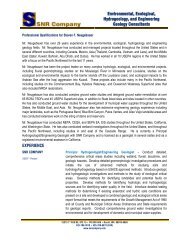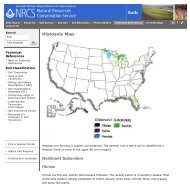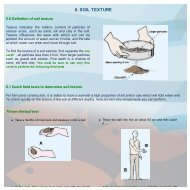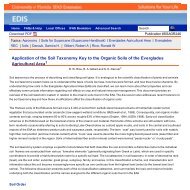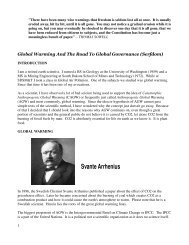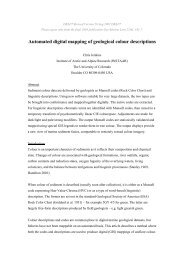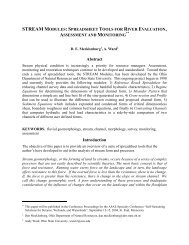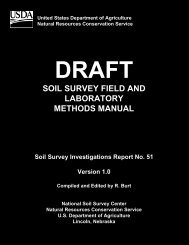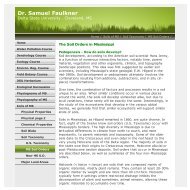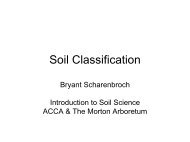chapter 3 fundamentals of fluvial geomorphology and stream ...
chapter 3 fundamentals of fluvial geomorphology and stream ...
chapter 3 fundamentals of fluvial geomorphology and stream ...
You also want an ePaper? Increase the reach of your titles
YUMPU automatically turns print PDFs into web optimized ePapers that Google loves.
to the channel-forming discharge. Dury (1961) also suggested thatthe channel-forming discharge is approximately equal to thebankfull discharge <strong>and</strong> Dunne <strong>and</strong> Leopold (1978) concluded thattheir maintenance discharge corresponded to the bankfull stage.Field identification <strong>of</strong> bankfull discharge is, however, problematic(Williams 1978). It is usually based on identification <strong>of</strong> theminimum width to depth ratio (Wolman 1955; Pickup <strong>and</strong> Warner1976), together with the recognition <strong>of</strong> some discontinuity in thenature <strong>of</strong> the <strong>stream</strong> such as a change in sedimentary orvegetative characteristics. Nixon (1959) defined the bankfull stateas the highest flood <strong>of</strong> a river that can be contained within the<strong>stream</strong> without spilling water on the river floodplain. Wolman <strong>and</strong>Leopold (1957) defined bankfull stage as the elevation <strong>of</strong> the activefloodplain. Woodyer (1968) suggested that bankfull dischargecorresponds to the elevation <strong>of</strong> the middle bench <strong>of</strong> rivers havingseveral overflow surfaces. Schumm (1960) defined bankfull as theheight <strong>of</strong> the lower limit <strong>of</strong> perennial vegetation, primarily trees.Similarly, Leopold (1994) states that bankfull is indicated by achange in vegetation, such as herbs, grasses, <strong>and</strong> shrubs. Finally,the bankfull stage is also defined as the average elevation <strong>of</strong> thehighest surface <strong>of</strong> the <strong>stream</strong> bars (Wolman <strong>and</strong> Leopold 1957).Harrelson et al. (1994) provide explanations <strong>of</strong> field methods forfield-determining bankfull discharge using vegetation, gradation <strong>of</strong>bank materials, <strong>and</strong> elevation <strong>of</strong> sedimentary features. Althoughseveral criteria have been identified to assist in field identification<strong>of</strong> bankfull stage, ranging from vegetation boundaries tomorphological breaks in bank pr<strong>of</strong>iles, considerable experience isrequired to apply these in practice, especially on rivers that have,in the past, undergone aggradation or degradation.3.5.2 Specified RecurrenceInterval DischargeProblems <strong>and</strong> subjectivity in the field identification <strong>of</strong>bankfull elevation <strong>and</strong> discharge make it attractive to use anobjectively defined discharge such as a specific recurrence intervalflow. This recurrence interval flow can, in turn, be related to thebankfull elevation (Table 3.2). Wolman <strong>and</strong> Leopold (1957)suggested that the bankfull frequency has a recurrence interval <strong>of</strong>one to two years. The most <strong>of</strong>ten-quoted recurrence interval is 1.5years. Dury (1973) concluded that the bankfull discharge isapproximately 97% <strong>of</strong> the 1.58-year discharge, or the mostprobable annual flood. Hey (1975) demonstrated that the 1.5-yearflow (annual maximum series) passed through the scatter <strong>of</strong>bankfull discharges along three British gravel-bed rivers. Richards(1982) suggests that, in a partial duration series, bankfulldischarge equals the most probable annual flood, which has a 1-year return period. Leopold (1994) concludes that mostinvestigations have found that the recurrence interval for bankfulldischarge ranges from 1.0 to 2.5 years. However, there are manyFundamentals <strong>of</strong> Fluvial Geomorphology <strong>and</strong> Stream Processes 35



